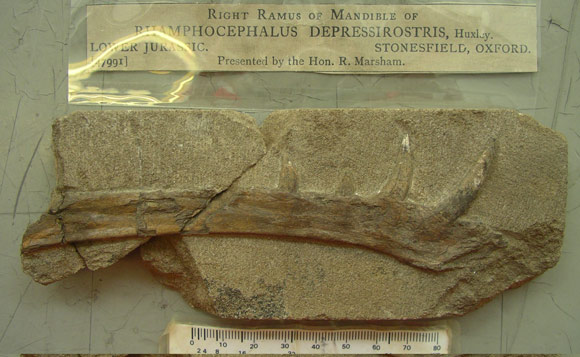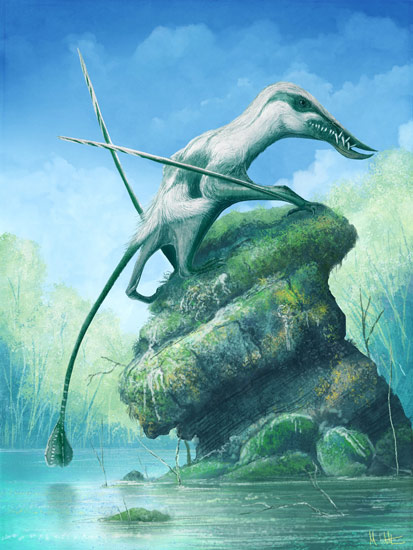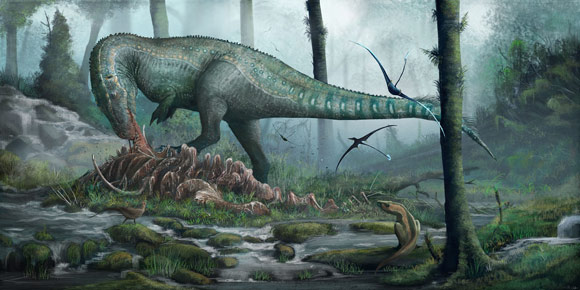Klobiodon rochei – Fanged Flier of the Middle Jurassic
The famous Stonesfield Slate mines located in Oxfordshire have provided palaeontologists with a rich assemblage of Middle Jurassic (Bathonian), marine and terrestrial fossils, perhaps most famously, the theropod Megalosaurus, the first dinosaur to be scientifically described. Joining “big reptile” as a member of the area’s prehistoric biota is a newly described, toothy pterosaur – Klobiodon rochei.
Writing in the academic journal Acta Palaeontologica Polonica, Dr Michael O’Sullivan, (University of Portsmouth), has reviewed the extensive but highly fragmentary pterosaur material and uncovered evidence of well-armed and substantial flying reptiles from historically important, but overlooked, British fossils.
A Life Reconstruction of the Middle Jurassic Rhamphorhynchid Pterosaur Klobiodon rochei
Picture credit: Mark Witton
An Uexpectedly Large and Formidable Flying Reptile
Working in collaboration with Professor David Martill (University of Portsmouth), Dr O’Sullivan examined many of the 215 fragmentary pterosaur fossils that have been collected from the Stonesfield Slate mines, K. rochei is one of the largest known from any Middle Jurassic-aged deposits. It had an estimated wingspan of two metres, making it about the size of a modern-day mute swan. Living around 166-165 million years ago, Klobiodon is an unexpectedly large and formidably-armed species.
Commenting on the significance of the newly described member of the Rhamphorhynchidae family, Dr O’Sullivan stated:
“It’s large fangs would have meshed together to form a toothy cage, from which little could escape once Klobiodon had gotten a hold of it. The excellent marine reptiles and ammonites of the UK’s Jurassic heritage are widely known, but we celebrate our Jurassic flying reptiles far less. The Stonesfield pterosaurs are rarely pretty or spectacular, but they capture a time in flying reptile evolution which is poorly represented globally. They have an important role to play in not only understanding the UK’s natural history, but help us understand the bigger global picture as well.”
Honouring Comic Book Artist Nick Roche
The genus name translates as “cage tooth”, a reference to its huge, fang-like teeth, up to 26 millimetres long, that lined the jaw (this pterosaur has been named based on the morphology of the lower mandible). The species name honours comic book artist Nick Roche in recognition of the role this popular media has in how extinct animals are portrayed. Comic books are a medium where prehistoric animals are portrayed in an increasingly scientifically accurate manner, Roche’s work at the turn of this century was one of the earlier examples of a revival of palaeoart.
The Lower Jaw of Klobiodon rochei

Only the lower jaw of Klobiodon is known, but it has a unique dental configuration that allows it to be distinguished from other pterosaurs. It probably fed on small fish and squid, filling a role in the coastal ecosystem of an extant seagull or tern.
A Confused Pterosaur Picture
Much of Dr O’Sullivan’s research has involved untangling the messy science associated with these neglected specimens. For example, the pterosaur specimens from the Great Oolite Group (Stonesfield Slate is a unit of the Great Oolite Group), are held in museums scattered across the world, although the majority are housed either at the London Natural History Museum or within the collection of the Natural History Museum of Oxford University. Most of these fossils were assigned in the 19th century to the genus Rhamphocephalus and to one of three species namely: Rhamphocephalus prestwichi, Rhamphocephalus bucklandi, and Rhamphocephalus depressirostris.
This study reviewed the British Middle Jurassic Pterosauria assemblage, evaluating both their systematics and taxonomic diversity. The holotype of Rhamphocephalus, an isolated skull table, is found to be a misidentified crocodylomorph skull and the genus is therefore considered a nomen dubium. The holotype of Rhamphocephalus bucklandi is identified as missing and that of Rhamphocephalus depressirostris has characters diagnostic at a family level, not a generic or specific one. Both species are considered dubious.
Klobiodon rochei
Detailed examination of the entire pterosaur fossil assemblage shows that these fossils actually represent at least five different taxa, representing three families. The researchers propose that the fossil material includes the earliest occurrences of the Monofenestrata clade and sub-order Pterodactyloidea, that was to give rise to some of the largest flying reptiles known to science.
Dr O’Sullivan explained:
“Klobiodon has been known to us for centuries, archived in a museum drawer and seen by dozens or hundreds of scientists, but it’s significance has been overlooked because it’s been confused with another species since the 1800s.”
A spokesperson from Everything Dinosaur stated:
“The pterosaur fossils associated with Middle Jurassic deposits of Oxfordshire and Gloucestershire have been neglected. Research undertaken in the 19th century suggested that this was a time of relatively low pterosaur diversity. This new research suggests that this was not the case, the Bathonian pterosaur assemblage is actually quite diverse with important early representatives of key types of flying reptile having been identified from this English fossil material.”
Stonefield Slate’s Most Famous Resident
Perhaps the most famous member of the Great Oolite Group biota is Megalosaurus bucklandii, the first dinosaur to be formally described. The name was first used by James Parkinson in 1822 and published by the Reverend William Buckland in 1824, when he described various fossil remains including an iconic lower jaw bone (right dentary). Size estimates vary for M. bucklandii, it could have been around ten metres in length. It was probably the apex predator within this ecosystem and it is intriguing to think that the likes of Klobiodon could have scavenged the kills of Megalosaurus.
A Life Reconstruction of the Stonefield Slate’s Most Famous Member – Megalosaurus bucklandii
Picture credit: Mark Witton
The scientific paper: “Pterosauria of the Great Oolite Group (Bathonian, Middle Jurassic) of Oxfordshire and Gloucestershire, England” by Michael O’Sullivan and David M. Martill, published in published in Acta Palaeontologica Polonica (editor’s choice).
Everything Dinosaur acknowledges the assistance of a press release from the University of Portsmouth in the compilation of this article.
Visit the Everything Dinosaur website: Everything Dinosaur.








Leave A Comment